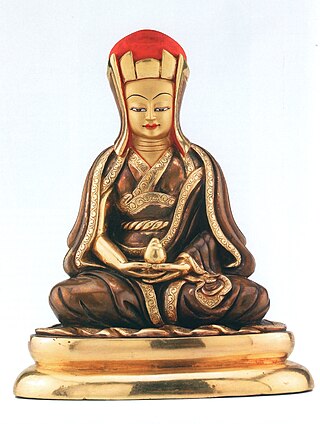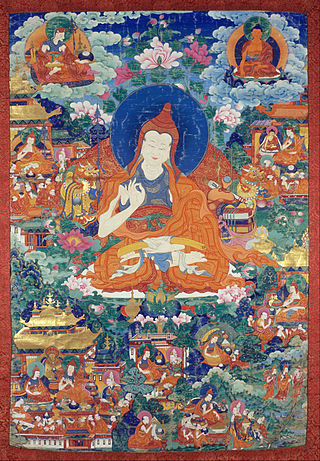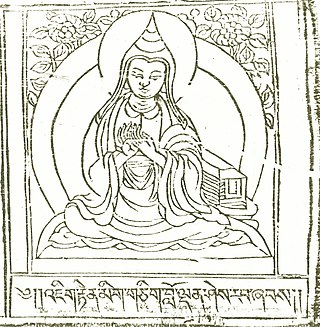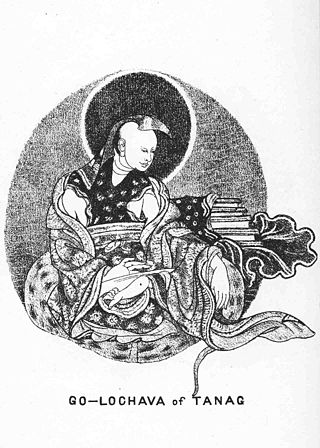| Part of a series on |
| Tibetan Buddhism |
|---|
 |

gZhon-nu-dpal (1392-1481), also known as 'Gos Lo-tsa-ba (full name: Yid-bzang-rtse gZhon-nu-dpal) was a famous Tibetan historian and scholar, known as the author of the "Blue Annals". [1]
| Part of a series on |
| Tibetan Buddhism |
|---|
 |

gZhon-nu-dpal (1392-1481), also known as 'Gos Lo-tsa-ba (full name: Yid-bzang-rtse gZhon-nu-dpal) was a famous Tibetan historian and scholar, known as the author of the "Blue Annals". [1]
He was born in 1392 at lho kha 'phyongs rgyas. He was a student of the fifth Karmapa Lama, Deshin Shekpa (1384-1415), from whom he received the bodhisattva precepts, as well as Tsongkhapa, and was a teacher of the sixth Karmapa, Thongwa Dönden (1416-1453). [2] He was the abbot of the Karmarñing Monastery and the author of the Blue Annals. [3] [4]

Padmasambhāva, also known as Guru Rinpoche and the Lotus from Oḍḍiyāna, was a tantric Buddhist Vajra master from medieval India who taught Vajrayana in Tibet. According to some early Tibetan sources like the Testament of Ba, he came to Tibet in the 8th century and helped construct Samye Monastery, the first Buddhist monastery in Tibet. However, little is known about the actual historical figure other than his ties to Vajrayana and Indian Buddhism.

The Kagyu school, also transliterated as Kagyü, or Kagyud, which translates to "Oral Lineage" or "Whispered Transmission" school, is one of the main schools of Tibetan Buddhism. The Kagyu lineages trace themselves back to the 11th century Indian Mahasiddhas Naropa, Maitripa and the yogini Niguma, via their student Marpa Lotsawa (1012–1097), who brought their teachings to Tibet. Marpa's student Milarepa was also an influential poet and teacher.

The Tibetan Buddhist canon is a loosely defined list of sacred texts recognized by various sects of Tibetan Buddhism. In addition to sutrayana texts from Early Buddhist schools and Mahayana sources, the Tibetan canon includes tantric texts. The Tibetan Canon underwent a final compilation in the 14th century by Buton Rinchen Drub (1290–1364).

Gampopa Sönam Rinchen was the main student of Milarepa, and a Tibetan Buddhist master who codified his own master's ascetic teachings, which form the foundation of the Kagyu educational tradition. Gampopa was also a doctor and tantric master. He authored the first Lamrim text, Jewel Ornament of Liberation, and founded the Dagpo Kagyu school. He is also known as Dvagpopa, and by the titles Dakpo Lharjé "the physician from Dakpo" and Daö Zhönnu, "Candraprabhakumara".
The Ratnagotravibhāga and its vyākhyā commentary, is an influential Mahāyāna Buddhist treatise on buddha-nature. The text is also known as the Mahāyānottaratantraśāstra. The RGVV was originally composed in Sanskrit, likely between the middle of the third century and no later than 433 CE. The text and its commentary are also preserved in Tibetan and Chinese translations.

Śāntarakṣita, whose name translates into English as "protected by the One who is at peace" was an important and influential Indian Buddhist philosopher, particularly for the Tibetan Buddhist tradition. Śāntarakṣita was a philosopher of the Madhyamaka school who studied at Nalanda monastery under Jñānagarbha, and became the founder of Samye, the first Buddhist monastery in Tibet.
The Guhyagarbha Tantra is the most important Buddhist tantra of the Mahayoga class and the primary tantric text studied in the Nyingma tradition. It is the main Nyingma source for understanding empowerment, samaya, mantras, mandalas and other Vajrayana topics, and has influenced the Dzogchen tradition. The Nyingma scholar Longchenpa sees it as "the highest summit of all vehicles, the source of all verbal transmissions, the great great shortcut of the vehicle of all Buddhas of the three times, the most secret."

Ralung Monastery, located in the Tsang region of western Tibet south of Karo Pass, is the traditional seat of the Drukpa Lineage of Tibetan Buddhism. It was founded in 1180 by Tsangpa Gyare, 1st Gyalwang Drukpa, a disciple of Lingje Répa who founded the Drukpa Lineage.
Ralung is one of the most sacred places in Tibet, for it is here that the great Dugpa school of red-hat monks originated, a school still influential with numerous adherents in Southern, Northern, and Eastern Tibet, and in Bhutan, which latter country is, in fact, called Dugpa owing to the preponderance of this sect. The Ralung-til, the head monastery of the Dugpa, is to the south-east of this village. This monastery owes its name to the fact that it is surrounded by mountains as the heart (mt'il) of a lotus is by the corolla.

Hevajra is one of the main yidams in Tantric, or Vajrayana Buddhism. Hevajra's consort is Nairātmyā.
The Blue Annals, completed in 1476, written by Gö Lotsawa Zhönnu-pel, is a Tibetan historical survey with a marked ecumenical view, focusing on the dissemination of various sectarian spiritual traditions throughout Tibet.
Rongzom Chökyi Zangpo, widely known as Rongzom Mahapandita, Rongzom Dharmabhadra, or simply as Rongzompa, was one of the most important scholars of the Nyingma school of Tibetan Buddhism. Together with Longchenpa and Ju Mipham, he is often considered to be one of the three "omniscient" writers of the school. His elder contemporary Atiśa (980–1054) considered Rongzompa to be an incarnation of the Indian ācārya Kṛṣṇapāda, the Great. The Tibetan historian Gö Lotsawa (1392–1481) said of Rongzom that no scholar in Tibet was his equal.

Trülku Drakpa Gyeltsen (1619–1656) was an important Gelugpa lama and a contemporary of the 5th Dalai Lama (1617–1682). His Seat was the upper residence of Drepung Monastery, a famous Gelug gompa located near Lhasa.

Ngok Loden Sherab or Ngok Lotsawa Loden Sherab (1059–1109) - Important in the transmission of Buddhism from India to Tibet. One of the most renowned translators in Tibetan history and traditionally known as one of the "Ten Pillars of Tibetan Buddhism". Also known as Matiprajna (Sanskrit).
Karma Gon Monastery, the original monastery of the Karma Kagyu sect of Tibetan Buddhism, was founded in the 12th century by Düsum Khyenpa, the 1st Karmapa Lama in eastern Tibet at the age of 76. Karma Gon, is located on the eastern bank of the Dzachu River in Chamdo, eastern Tibet. Karma Dansa was the cradle of the karma kagyupas. When established the Karmapa had gathered 1000 monks around him here. Karma Gon was named as Karma Dansa as an administrative unit and the Chinese Ming Court enlarged the monastery’s jurisdiction by adding the Mekong’s middle and upper reaches. It was then also called Gama Dansa Si in Chinese.

Gö Khugpa, 'Gos Khug-pa Lhas-btsas, Gö Kuk-ba-hlay-dzay, is also written as Khug-pa-Lhas-tsi, or simply 'Gos, was a famous Tibetan monk and translator of the 11th century.

George Nicolas de Roerich was a prominent 20th century Tibetologist. His name at birth was YuriNikolaevich Rerikh. George's work encompassed many areas of Tibetan studies, but in particular he is known for his contributions to Tibetan dialectology, his monumental translation of the Blue Annals, and his 11-volume Tibetan-Russian-English dictionary.

Phagmo Drupa Dorje Gyalpo [1110-1170], was one of the three main disciples of Gampopa Sonam Rinchen who established the Dagpo Kagyu school of Tibetan Buddhism; and a disciple of Sachen Kunga Nyingpo [1092-1158] one of the founders of the Sakya school of Tibetan Buddhism. He was the elder brother of Kathog Dampa Deshek [1122-1192], who founded Kathog monastery and the Kathog branch of the Nyingma school.
Dagpo Kagyu Tibetan: དྭགས་པོ་བཀའ་བརྒྱུད, Wylie: dwags po bka' brgyud encompasses the branches of the Kagyu school of Tibetan Buddhism that trace their lineage back through Gampopa (1079-1153), who was also known as Dagpo Lhaje "the Physician from Dagpo" and Nyamed Dakpo Rinpoche "Incomparable Precious One from Dagpo". All the institutional branches of the Kagyu tradition of Tibetan Buddhism surviving today, including the Drikung Kagyu, the Drukpa Lineage and the Karma Kagyu, are branches of the Dagpo Kagyu.
Zhang Yudrakpa Tsöndru Drakpa (1122–93) (zhang g.yu brag pa brtson 'gru brags pa), also known as Gungtang Lama Zhang(gung-thang bla-ma zhang) and often simply as Lama Zhang, was the founder of the Tshalpa Kagyu sect of Tibetan Buddhism. He was a prominent religious figure, and his extensive involvement in the political and military conflicts of Tibet was controversial at the time. Lama Zhang played a key role in the medieval Buddhist revival in Central Tibet, also called the “Tibetan renaissance”.
The Bodongpa or Bodong tradition, is one of the smaller traditions of Tibetan Buddhism falling outside the classification of the four main schools.